Guppies look beautiful, don’t they? Probably you’ve seen them in your friend’s aquarium or in a restaurant’s fish tank you’ve recently visited. And you have just fallen in love with them.
Now you want to keep some guppies!
But you’re wondering, are they easy to take care of?
No worries…In this article, I’m going to answer the same question.
I’ll also tell you how to take care of guppies.
We have got a lot to cover here. So let’s get into it.
Guppies are one of the easiest freshwater fish to take care of. They are very hardy and can tolerate a wide range of water parameters. You’ll just need to keep your fish tank clean, maintain the ideal water parameters and feed high-quality food to keep guppies successfully in your aquarium.
Now that you know guppies are very easy to take care of, I know you’re very excited to get the guppies.
But, though guppies are very hardy and easy to take care of, still, you’ll need to provide them the ideal environment to keep them happy and healthy in your tank.
I am going to tell you everything you need to know to keep guppies successfully in your fish tank.
Keep reading…
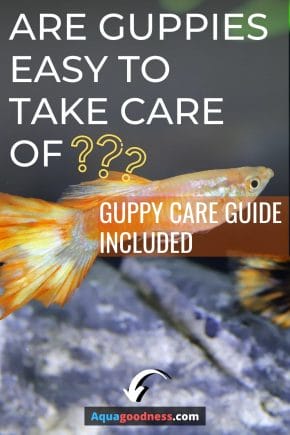
Table of Contents
Why are guppies considered easy to care for freshwater fish?
Guppies are very adaptive fish. They can easily adapt to most tropical environments.
This is the reason they are found all over the world except Antarctica.
Guppies are so adaptive that, though they are freshwater fish they can be fully acclimated to saltwater.
Many saltwater owners use guppies to cycle their tanks.
Are guppies good for beginners?
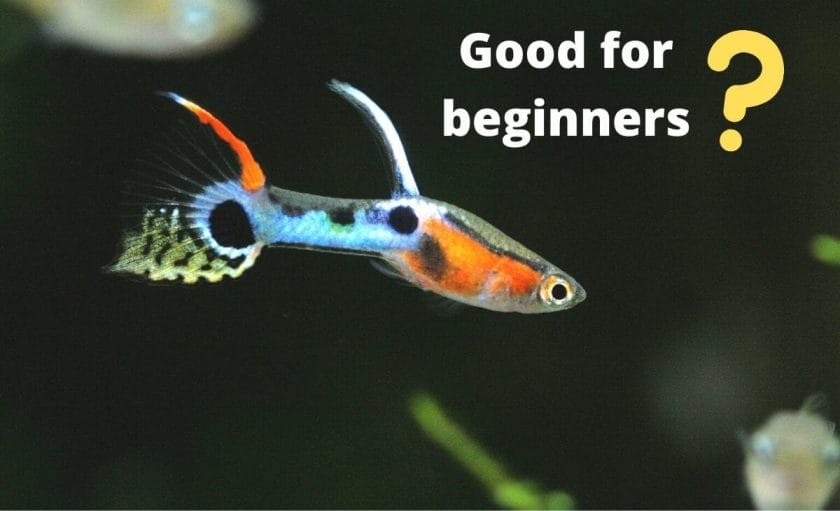
If you’re just starting in the fishkeeping hobby, guppies are one of the best fish to start with.
There are several reasons guppies are good for beginners.
1. Guppies can tolerate a wide range of water parameters
When you are just starting in the fish-keeping hobby it can be tricky to maintain the ideal water parameters that the fish need in the tank.
If you have very sensitive and delicate fish in your fish tank then, in this case, they may not be able to tolerate the changes in the water parameters.
That’s why it is very important to start with some hardy fish that can tolerate a wide range of water parameters.
So even if sometimes the water parameters are not in the ideal range, still the fish will be able to handle the water parameter changes.
Guppies can tolerate a wide range of water parameters. And guppies can handle the water parameter fluctuations. This is the reason guppies are a good choice for beginner fishkeepers.
This does not mean that you should not care about maintaining the ideal water parameters in your guppy fish tank.
Maintaining the ideal water parameters will keep your guppies stress-free and happy in your fish tank. And it will also help to improve the longevity of your guppies.
That being said, as I mentioned above, guppies can tolerate water parameter fluctuations. So they will be able to handle the changes until you bring the water parameters within the ideal range.
2. Guppies are very cheap
When you are just starting in the hobby, probably, you don’t want to spend a lot of money on your first fish tank.
You’re just testing the waters and you don’t know for sure if fishkeeping is for you!
So, in this case, it makes sense to keep guppies as your first pet fish because they are very cheap.
You can get guppies for as cheap as 3 to 4 dollars for a fish.
You can buy guppies at a very cheap price at Amazon here.
3. Guppies are very cheap and easy to maintain
As mentioned earlier, guppies are very hardy and can tolerate a wide range of water parameters.
That’s why you don’t need a lot of fancy equipment to maintain the ideal water parameters in your guppy fish tank.
Besides, guppies are small freshwater fish so you don’t need a big tank and larger equipment to start keeping guppies.
You can keep a trio of guppies in a 5 gallon!
How to set up a guppy fish tank? (step-by-step)
Now I am going to show you the exact step-by-step process of setting up a guppy fish tank.
Equipment you’ll need to set up a guppy fish tank
Before getting into the setup process, first, let’s see what equipment you will need to set up the fish tank
1. Fish tank

Obviously, you will need a fish tank to keep guppies.
You can keep a trio of guppies in a 5-gallon fish tank.
But generally, it is not recommended to keep guppies in a 5-gallon tank because guppies breed a lot.
So soon you will end up with a lot of guppies in a 5-gallon fish tank. And you will need to upgrade the tank to a 10 to 15-gallon tank.
That’s why ideally you should start with a bit bigger tank of at least 10 gallon or 15 gallon tank.
Another important reason to start with a bigger tank is that, usually, it is easier to maintain the ideal water parameters in a larger tank.
In smaller tanks, water parameters can change very quickly compared to a bigger tank.
I recommend starting with at least a 10-gallon tank for your guppies.
2. Aquarium filter
You will need an aquarium filter to keep the water clean in your fish tank.
Besides keeping the water clean, another important benefit of an aquarium filter is that it provide a very good place for the beneficial bacteria to form their colonies.
Beneficial bacteria are nitrifying bacteria that convert the harmful ammonia produced in your fish tank due to fish poop into less harmful nitrite and nitrate.
Warning: Ammonia is deadly for the fish.
Even a slight ammonia level in your fish tank can lead to the death of the fish in your fish tank.
That’s why it is very important to have a healthy amount of beneficial bacteria in your fish tank.
How to choose the right aquarium filter for your aquarium?
There are a few types of aquarium filters available for a fish tank.
If you are starting with a 10-gallon tank then I recommend you to get a hang on the back filter for your fish tank.
There are a few benefits of choosing a hang-on-the-back filter for smaller tanks compared to other filters.
- Hang on the back filter sits outside of your fish tank so it will not occupy space in your fish tank
- Hang on the back filter also produces water agitation on the surface of the water of your fish tank which helps to oxygenate a fish tank.
- Hang on the back filter is also very easy to clean.
- Hang on the back filters are cheap
I recommend MarineLand Penguin hang on the back filter (link to Amazon).
It is a very reliable filter and it comes in different sizes so you can choose according to the tank size of your fish tank.
You can check its latest price and reviews at Amazon here.
3. Aquarium heater
Guppies are tropical fish. Naturally, they are found in tropical environments.
In tropical environments, the temperature is warmer (more than 18°C or 64.4°F).
That’s why guppies need warmer water in a fish tank.
To maintain and keep the temperature in your fish tank warm you will need to install an aquarium heater.
I recommend Cobalt Aquatics Flat Neo-Therm Heater (link to Amazon)
It comes with a built-in thermostat so you will just need to set the temperature and it will keep the temperature within the ideal range.
We will talk about the ideal temperature range for guppies later in the article along with other water parameters.
4. Aquarium light

There are several benefits of installing an aquarium light in your fish tank.
- Aquarium lights help to maintain the natural day and night cycle in your fish tank. Maintaining a continuous day and night cycle in a fish tank is very important to maintain the proper health of your fish.
- Aquarium lights help to enhance the color of the guppies in your fish tank. Under aquarium lights, your guppies will look more vibrant and colorful!
I recommend Finnex Stingray 2 Aquarium LED Light (link to Amazon)
It is a very cheap and reliable light.
You can check out its latest price and reviews at Amazon here
5. Substrate
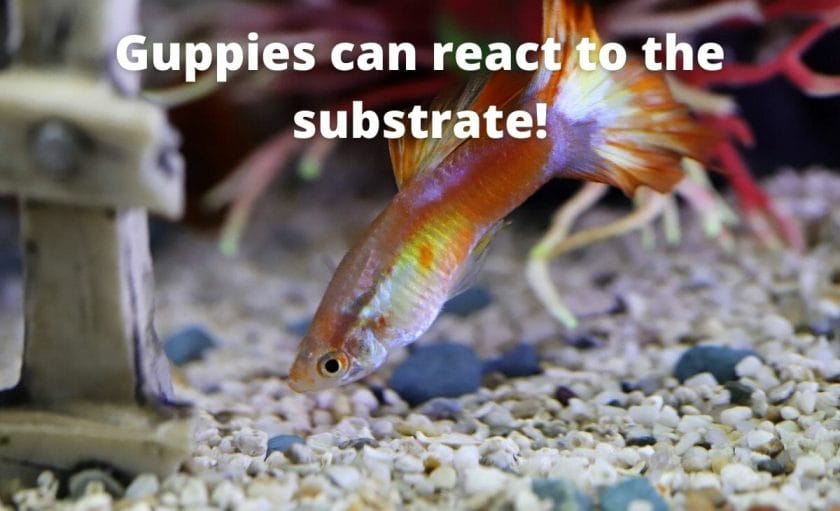
This is the fun part of the aquarium setup process.
You can choose substrate any substrate of your choice to design your aquarium and give it a unique look!
Interesting fact: Guppies in your fish tank can change colors and react to the coloration of the substrate of the fish tank.
You can either use sand or gravel as a substrate for your fish tank.
There are a few varieties available in a sand substrate and gravel substrate.
For example, there is white sand, black sand, brown sand, etc
| Sand color | Buy at Amazon |
| Brown aquarium sand | Click here |
| White aquarium sand | Click here |
| Black aquarium sand | Click here |
There is also a lot of variety available when it comes to gravel for your fish tank.
Heads up- If you are going to put gravel as a substrate in your guppy fish tank then just make sure to choose the gravel which doesn’t have sharp edges. Sharp edges can scratch the delicate bodies of fish which can lead to bacterial infection.
6. Aquarium plants
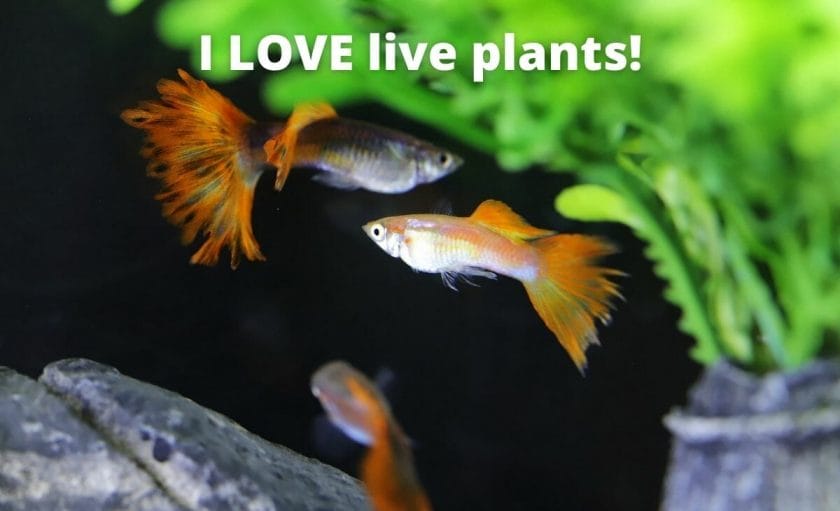
To decorate your guppy fish tank with plants either you can use artificial plants or you can also use put some live aquarium plants in your fish tank.
There are some benefits of keeping some live aquarium plants over artificial plants.
- Live aquarium plants help to oxygenate a fish tank.
- Live aquarium plants provide a natural look to your fish tank.
- Live aquarium plants also help to filter the water in your fish tank by absorbing harmful ammonia, nitrite, and nitrate from the water of your fish tank.
- Here are the other 12 benefits of keeping live aquarium plants in your fish tank
If you want to keep some live aquarium plants in your fish tank then here is the link to the article containing the best live aquarium plants for guppies.
Thought this could be helpful to you: 6 tips to take care of live aquarium plants.
7. Other aquarium decorations
To decorate your fish tank and give it a unique look, you can keep some other decorations in your fish tank.
While choosing the decoration for your fish tank make sure that the decorations are not made from any material that can alter the water chemistry in your fish tank.
For example, if you put an ornament that is made from limestone then it can increase the pH in your aquarium water.
How to set up a guppy fish tank? (A step by step guide)
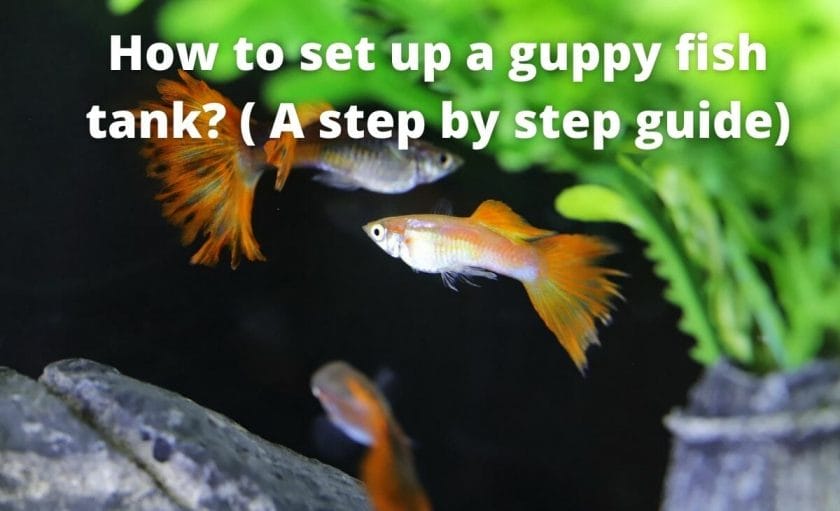
Now I am going to show you the exact step-by-step process of setting up a guppy fish tank.
- First of all, add the substrate of your choice to the fish tank. The substrate base should be around 2 inches thick.
- Now take a bucket that you have never used with any chemicals like detergent or any type of cleaning agent. And pour down water into the bucket.
- Now you will need to dechlorinate the water before adding it to the fish tank. You can easily dechlorinate the water using a dechlorinator (link to Amazon). Just add the dechlorinator according to the instruction mentioned on the bottle to dechlorinate the water.
- Now add the water into the fish tank until half of the fish tank is filled.
- At this point, you should put live aquarium plants into the fish tank
- Also, you should put any other decorations of your choice at this stage in your fish tank.
- Now set up an aquarium filter in your fish tank. I recommended this aquarium hang on the back filter (link to Amazon). You’ll need to put it outside of your aquarium on the glass wall of the fish tank.
- Now you should set up an aquarium heater in your fish tank.
- If you want to add an air pump (link to Amazon) to your fish tank then you should add it at this point of the setup process.
- Now again pour down water into the fish tank and fill the fish tank.
- Now you should set up an aquarium light on your fish tank.
- Once all the equipment is set up, now it is time to cycle your fish tank before adding guppies to your tank.
- There are different methods of cycling a fish tank. It can take about an hour to a month to complete the nitrogen cycle process in your fish tank. I have written a detailed article covering different methods of cycling a fish tank with exact instructions on how to cycle the fish tank. You can read the article here.
- Once your fish tank is cycled then now it is time to add puppies to your fish tank.
- Once you’ve got guppies then, first of all, you will need to acclimate the guppies before adding them to your fish tank. To acclimate guppies just keep the carry bag that contains the fish floating on the surface of the water of your fish tank for about an hour.
- Now pull out guppies from the carry bag using a fishnet and put them in your fish tank. Don’t add the water from the carry bag into your fish tank!
- That’s it that’s how you set up a guppy fish tank!
How to set up a guppy fish tank? (A step by step video)
This video does not have a voice-over so you can watch it muted!
How to take care of guppies?
Now I am going to share with you some tips to take care of your guppies.
1. Maintain good water quality

Maintaining good water quality is very important if you want to keep your guppies happy and healthy in your fish tank.
Keep the temperature between 72° F to 78° F (22° C to 25° C)

The ideal temperature range for guppies is between 72° F to 78° F (22° C to 25° C).
If the temperature in your fish tank is below 72° F (22° C) then the guppies will grow very slowly. And they may never reach their maturity.
On the other hand, if the temperature in your fish tank is more than 78° F then guppies will grow very fast. And this may reduce their life span.
You can easily maintain the ideal temperature range if you use an aquarium heater with a built-in thermostat.
I recommend Cobalt Aquatics Flat Neo-Therm Heater (link to Amazon) because it has a built-in thermostat. And it is a very reliable aquarium heater.
You can check out its latest price and reviews at Amazon here.
Maintain the pH between 7 to 7.2 in your guppy fish tank
The ideal pH range for guppies is between 7 to 7.2.
So, you should maintain the pH in your aquarium water between 7 to 7.2.
You can test the current pH of your aquarium water using an aquarium water test kit (link to Amazon).
If you noticed that the pH of your aquarium water is lower than 7 then you can add baking soda (about 1 tablespoon for 5 gallons of your aquarium water) to increase the pH in your aquarium water.
If you notice that the pH of your aquarium water is more than 7.2 then adding peat moss or natural driftwood in the fish tank can help to lower the pH in your aquarium water.
Make sure your fish tank contains sufficient oxygen
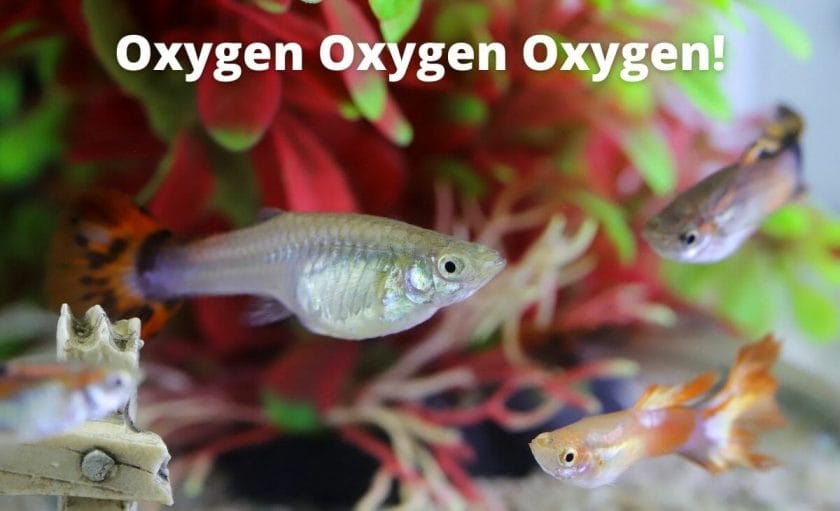
Guppies need dissolved oxygen in a fish tank to survive.
That’s why your fish tank must contain a sufficient amount of oxygen for guppies in your fish tank.
Generally, you should not bother about testing the current oxygen levels in your fish tank because the oxygen measuring equipment is quite expensive.
And honestly, you don’t need it because if your fish tank is set up well then it will contain a sufficient amount of oxygen.
What do I mean by “if the fish tank is set up well”?
Basically, there should be some water agitation going on the surface of your aquarium water.
Gas exchange happens on the surface of the water so water agitation will oxygenate the fish tank.
Generally, if you have a hang on the back filter or sponge filter then the water coming out from the hang on the back or sponge filter will produce sufficient surface agitation to keep your fish tank well oxygenated.
If you want to be 100% sure that your fish tank always has sufficient oxygen then you can install an air pump in your fish tank.
I recommend Tetra whisper air pump (link to Amazon).
It is a very quiet air pump and it is very reliable.
You can check out its reviews and latest price at Amazon here.
It will produce water agitation on the surface of your aquarium water which will help to oxygenate your fish tank.
Besides, here are some other ways to oxygenate your fish tank.
Keep ammonia, nitrite, and nitrate under control
Ammonia is deadly for guppies in your fish tank.
That’s why you should always make sure that you are fish tank doesn’t contain any ammonia.
So how do you make sure that your fish tank will never contain any ammonia?
Well, first of all, you will need to properly cycle your fish tank.
If you don’t know here is the article that explains what cycling a fish tank means and how to cycle your fish tank.
Once your fish tank is properly cycled then your fish tank will not have ammonia in it.
However, over time, nitrate will build up in your fish tank.
Now a small amount of nitrate (less than 40 PPM) is not deadly for the fish.
But if you are fish tank contains more than 40 PPM nitrate then you will need to remove it from your fish tank.
Generally, doing a partial water change on a weekly basis is sufficient to remove the excess nitrate from your fish tank.
That’s why you should keep up with the weekly partial water changes to keep your aquarium water clean and safe for guppies in your tank.
2. Feed high quality and varied diet to your guppies
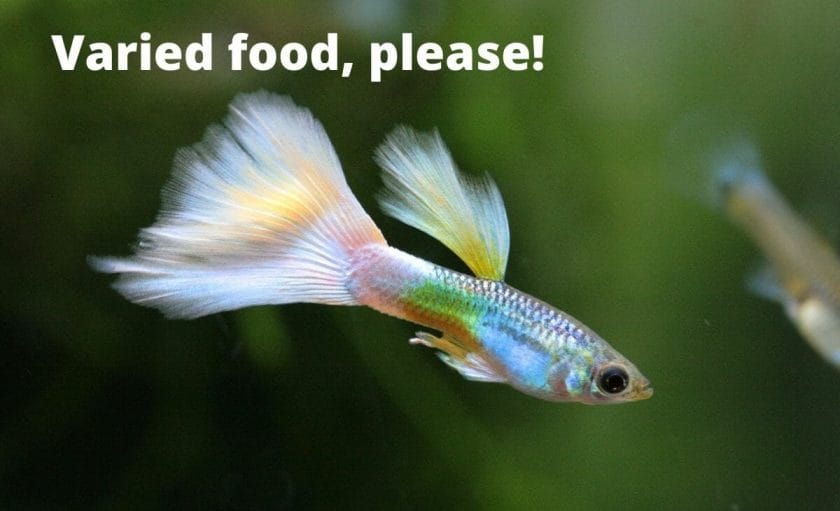
For proper and healthy growth of your guppies feeding high quality and balanced diet is very important.
Guppies are omnivorous so they can eat both plant-based and meaty foods.
That’s why your guppies diet should be varied and it should contain both plant-based and meaty foods.
Feeding high-quality foods to guppies also helps to enhance the coloration of your guppies.
What can you feed your guppies?
Now I am going to tell you the different types of food you can feed to your guppies.
Live food
In the natural habitat guppies mostly feed on live food.
Live food is the most nutritious food you can feed to your guppies.
That’s why you should regularly feed live food to your guppies.
| Live food for guppies | Buy at Amazon |
| Mosquito Larvae | Click here |
| Live Daphnia | Click here |
| Baby Brine Shrimp | Click here |
Flakes and pellets
On a daily basis, you should feed flakes and pellets to your guppies.
| Flakes and pallets for guppies | Check reviews and the latest price at Amazon |
| New Life Spectrum Optimum Flakes | Click here |
| New Life Spectrum pellet | Click here |
| Aquacarium Tropical Flakes | Click here |
There are also some special foods that are made to enhance the coloration of guppies.
| Color enhancing foods for guppies | Check reviews and the latest price |
| Check reviews and the latest price at Amazon here | |
| Fluval Bug Bites Color Enhancing Fish Food | Check reviews and the latest price at Amazon here |
| TetraColor PLUS Tropical Flakes with Color Enhancing | Check reviews and the latest price at Amazon here |
| Aqueon Tropical Color Enhancing Flakes | Check reviews and the latest price at Amazon here |
As guppies are omnivorous they need vegetarian or plant-based food for their proper growth.
| Plant-based fish food for guppies | Check reviews and the latest price |
| New Life Spectrum AlgaeMax | Check reviews and the latest price at Amazon here |
| Aquacarium Spirulina Flakes Natural Fish Food | Check reviews and the latest price at Amazon here |
| Aquacarium Veggie Flakes Natural Fish Food | Check reviews and the latest price at Amazon here |
Besides the above foods, you can also feed different veggies to your guppies.
I have written a detailed article covering different types of vegetables you can feed your guppies and how to prepare and feed them. You can read the article here
How much and how often you should feed your guppies?
Generally, you should feed two times a day to your guppies.
And you should feed the amount of food that your guppies can consume within two minutes.
Overfeeding guppies can result in constipation which can even lead to the death of your guppies.
That’s why it is very important to not overfeed your guppies.
Also, after feeding your guppies, make sure to remove any uneaten food.
If you don’t the uneaten food then it can produce ammonia in your fish tank which is deadly for the fish!
3. Keep up with the maintenance of your fish tank
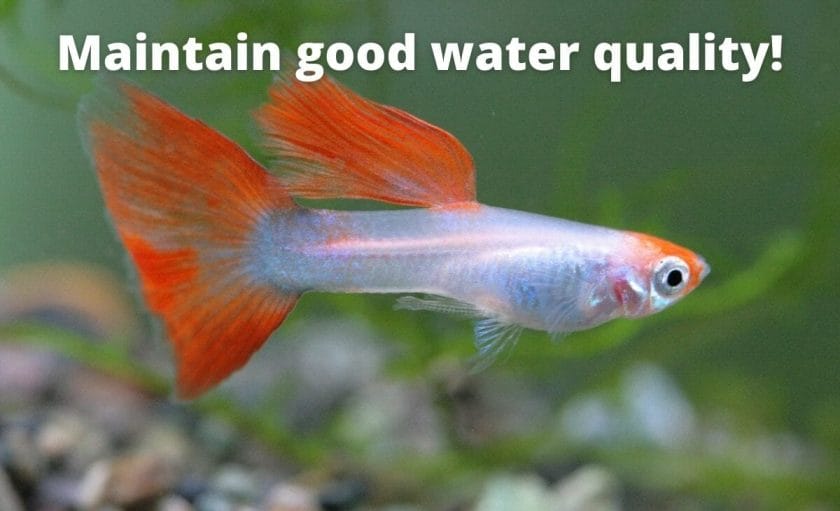
To provide the ideal and healthy environment to your guppies you will need to keep up with the regular maintenance of your fish tank.
Daily maintenance tasks for your fish tank
- After feeding your guppies you should remove the uneaten food from your fish tank. If you don’t remove uneaten food from your fish tank then over time the uneaten food will break down and produce ammonia in your fish tank which is deadly for the guppies in your fish tank. You can use a siphon (link to Amazon) to remove the uneaten food from your fish tank.
- On a daily basis, you should also check the temperature of the water in your fish tank. You could install a thermometer (link to Amazon) in your fish tank which will continuously check the temperature of the water in your fish tank.
- On a daily basis, you should also check the behavior of the fish in your fish tank. This is important because this will help you to identify any symptoms of diseases at the early stage.
Weekly maintenance task for your guppy fish tank
- You should do a partial water change of about 30 to 50% of the total aquarium water. Doing the partial water change will help reduce the nitrates level in your fish tank. Also, before adding the water make sure to dechlorinate the water.
- On a weekly basis, you should also siphon the substrate of your fish tank. Usually, debris and uneaten food are trapped into the substrate of your fish tank. These things can break down and produce ammonia in your fish tank which can be deadly for your fish. You can use a siphon (link to Amazon) to remove this stuff from your fish tank.
- You should also test the pH, GH, and ammonia, nitrite, and nitrate levels in your fish tank water. You can easily test your aquarium water using an aquarium water test kit (link to Amazon). If anything looks out of range then you should take action to get it in the ideal range.
- You should also clean the inside glass wall of your fish tank every week. You can use an algae scraper (link to Amazon) to clean the glass walls of your fish tank.
Monthly maintenance tasks for your guppy fish tank
- Every month you should test the water in your aquarium for pH, GH, and ammonia, nitrite, and nitrate. If anything looks out of range then you should take action to get it in the ideal range. You can use an aquarium water test kit (link to Amazon) to test the water of your fish tank
- If you had put some live aquarium plants in your fish tank, you should also trim the plant on a monthly basis if necessary.
- Every month you should also clean the filter media in your aquarium filter. You need to be careful while cleaning your aquarium filter because if you don’t clean your aquarium filter properly then and there is a chance that you will lose all the beneficial bacteria in your fish tank filter. Here is the article that shows you the exact process of cleaning your aquarium filter.
You may be interested in– Keeping up with the regular maintainance of the fish tank is one of the things you can do to keep your guppies happy and healthy. Know all the other ways of keeping your guppies happy and healthy in your tank.
4. Watch out for early signs of diseases
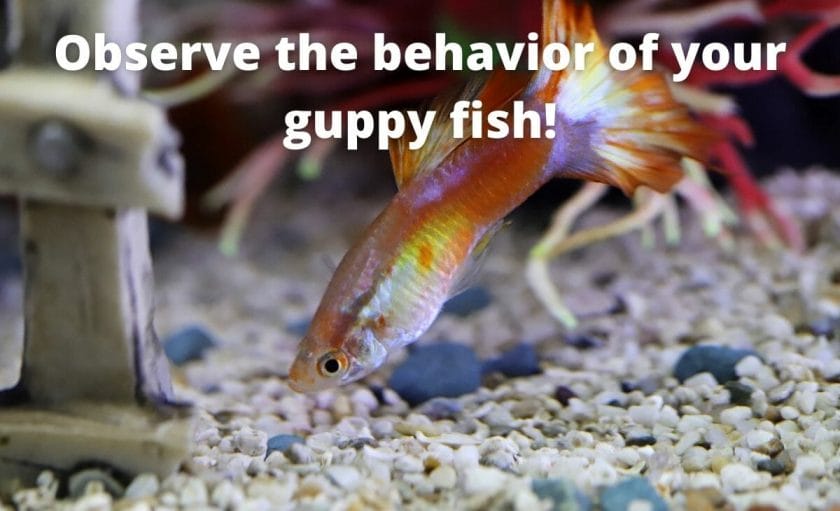
Spotting diseases at an early stage in your fish is very important.
If you noticed the disease at a later stage then the possibility of fish’s survival decreases drastically.
The most common diseases in guppies are ich, fin rot, and guppy disease.
These diseases are fairly easy to identify.
So you should regularly observe your guppies in your fish tank and see if they are showing any symptoms of any of the diseases.
I have covered all these three diseases their symptoms and treatments in this article.
Conclusion
Guppies are very hardy fish and they can tolerate a wide range of water parameters. That’s why they are very easy to take care of.
If you are a beginner and just starting in the fishkeeping hobby then guppies are a very good choice as your first aquarium fish.
To keep your guppies happy and healthy in your fish tank you will need to create an ideal environment in your fish tank.
The tips I have mentioned in this article will help you in creating an ideal environment for the guppies in your fish tank.
I hope you found the article helpful.
If you do please share it.
Happy fishkeeping!